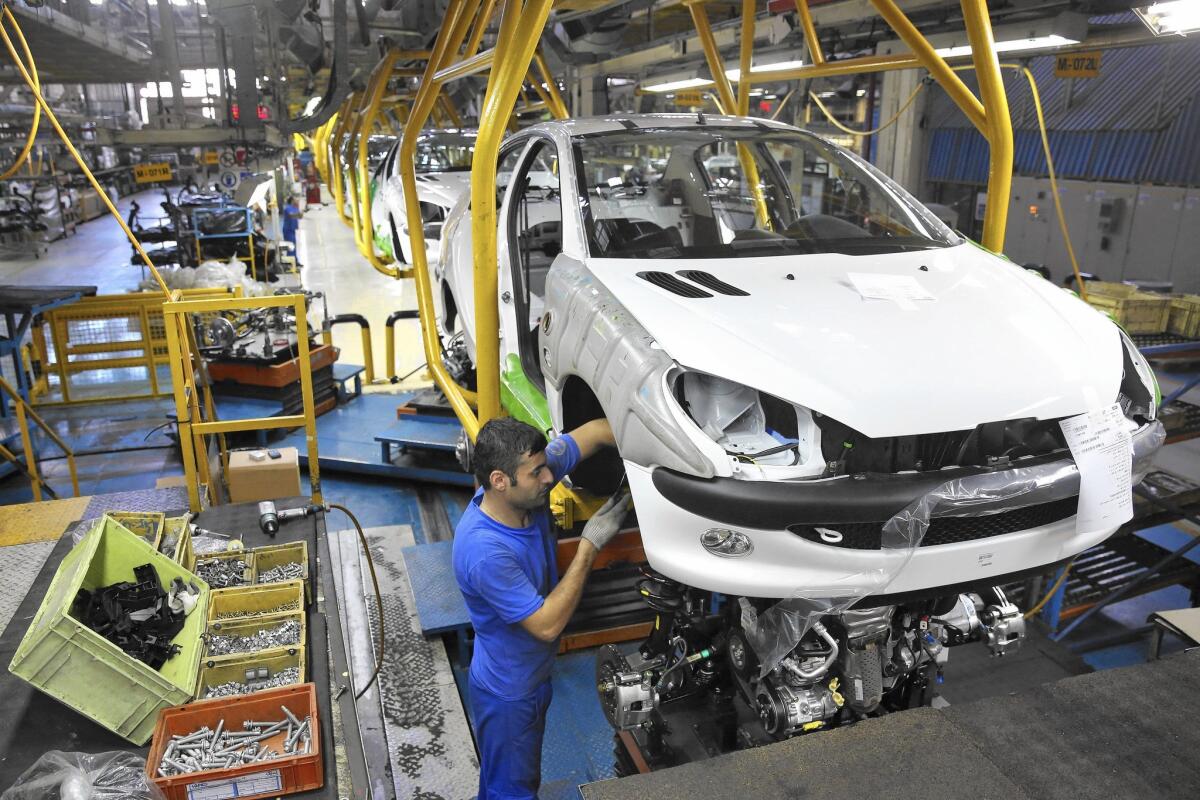Where are Iran’s billions in frozen assets, and how soon will it get them back?

- Share via
Iran’s “frozen” money has begun to thaw.
For years, Iran had tens of billions of dollars worth of funds that were languishing in banks, unable to be used, because of global sanctions.
That began to change Tuesday, when the head of Iran’s central bank announced that the nation had successfully transferred billions worth of assets from banks in South Korea and Japan to banks in Germany and the United Arab Emirates.
The transfers came with the lifting of some sanctions on Iran last week as part the deal Iran struck to place restrictions on its nuclear program.
The U.S. has a long history of sanctioning Iran, a longtime geopolitical foe, starting with Iran’s Islamic Revolution in 1979, and continuing through the ‘80s and ‘90s as U.S. officials accused Iran of backing groups seen as engaging in terrorism.
The result is that Iran has been “almost completely isolated from the international financial system,” David S. Cohen, former Treasury undersecretary for terrorism and financial intelligence, told Congress last year.
Iran lost access to tens of billions of dollars worth of funds in foreign banks. Exactly how much money was locked up is hard to pin down. Some American experts believe it reached more than $100 billion — enough, Cohen noted, to limit Iran’s ability to stabilize its currency and conduct foreign trade.
Nader Habibi, a professor of economics at Brandeis University who has tried to figure out the exact number, says the nuclear sanctions lifted last week will probably free up only about $30 billion worth of assets. Iran’s central bank chief, Valiollah Seif, had a similar estimate this week — about $32 billion.
“I think partly the dispute or disagreement is because some of Iran’s funds have been blocked for a long time, and they have nothing to do with the nuclear agreement,” said Habibi, who thinks the larger estimates include Iranian funds that have been frozen in foreign banks dating back to the Iranian Revolution. “I think this number [$32 billion] is closer to reality than $100 billion.”
Join the conversation on Facebook >>
Much of the frozen cash comes from revenue accrued by Iran as it continued to sell a limited amount of oil to a small number of countries including South Korea, Japan, China and India.
Although the oil sales to those countries were legal — Iran was allowed to sell up to 1 million barrels per day before sanctions were lifted — the money for the sales “would sit in one of those banks in their countries, but [the money] could not be transported, because it was illegal under U.S. sanctions,” Habibi said.
There has been some concern that Iran might use the money it’s now recovering to fund opponents of U.S. policy in the Middle East, including the Lebanese Shiite militia Hezbollah, the Palestinian militant group Hamas, and the Syrian government. But many experts think it’s more likely that Iran will primarily use the money to shore up its flagging economy and create jobs.
“By and large, they’re probably going to use this money at home,” said Richard Nephew, a former sanctions chief of the U.S. negotiating team who is now a fellow at the Center on Global Energy Policy at Columbia University in New York.
“What the government wants to do if President [Hassan] Rouhani can really control the course of events is put this money in the central bank as sort of a security to entice foreign investors to come to Iran and invest,” said Habibi, who also cautioned that Rouhani was “not the only one in control” of political decisions in Iran.
“There is a lot of domestic demand for funds at the moment,” Habibi said. “Many projects have been half-abandoned because of lack of funds,” and so some money will go to maintenance and repairs, for the auto industry and also for the oil industry. Iran also needs to buy a large number of new airplanes and parts for its aging aerial fleet.
Although the newfound billions are eye-grabbing, Nephew thinks Iran’s ability to export oil again, import gasoline and petroleum products, and regain access to international creditors will probably play a bigger role in reviving the nation’s economy.
“Iran’s overall economic relief as a result of [the lifting of] sanctions is multiples of this amount” currently frozen in banks, said Mark Dubowitz, director of the Foundation for Defense of Democracies, a conservative think tank in Washington that has been critical of Iran. “Ultimately it will prove to be a rounding error compared to what Iran will earn over the next number of years.”
NEWSLETTER: Get the day’s top headlines from Times Editor Davan Maharaj >>
At least 400 Iranians will be removed from U.S. government blacklists, while Europe will allow trade in software, gold and metals and transportation equipment, as the Los Angeles Times has reported.
The U.S. embargo on trade with Iran will continue, but several exceptions will be allowed, including the import and export of food and carpets.
But with the U.S. retaining the power to deem certain Iranians as terrorism sponsors, the U.S. can still frighten European banks away from certain investments in Iran, Nephew said.
“We didn’t actually give them a blank check; we didn’t clean the slate,” Nephew said. “We still have a lot of sanctions authority that’s going to make life difficult for businesspeople in Iran.”
The Associated Press contributed to this report.
Follow @MattDPearce for national news
MORE ON IRAN
After sanctions, politics in Iran are the next hurdle to better ties with U.S.
Don’t think that the U.S. and Iran are done butting heads
Pentagon report: Iran took SIM cards from detained U.S. sailors’ phones
More to Read
Sign up for Essential California
The most important California stories and recommendations in your inbox every morning.
You may occasionally receive promotional content from the Los Angeles Times.











